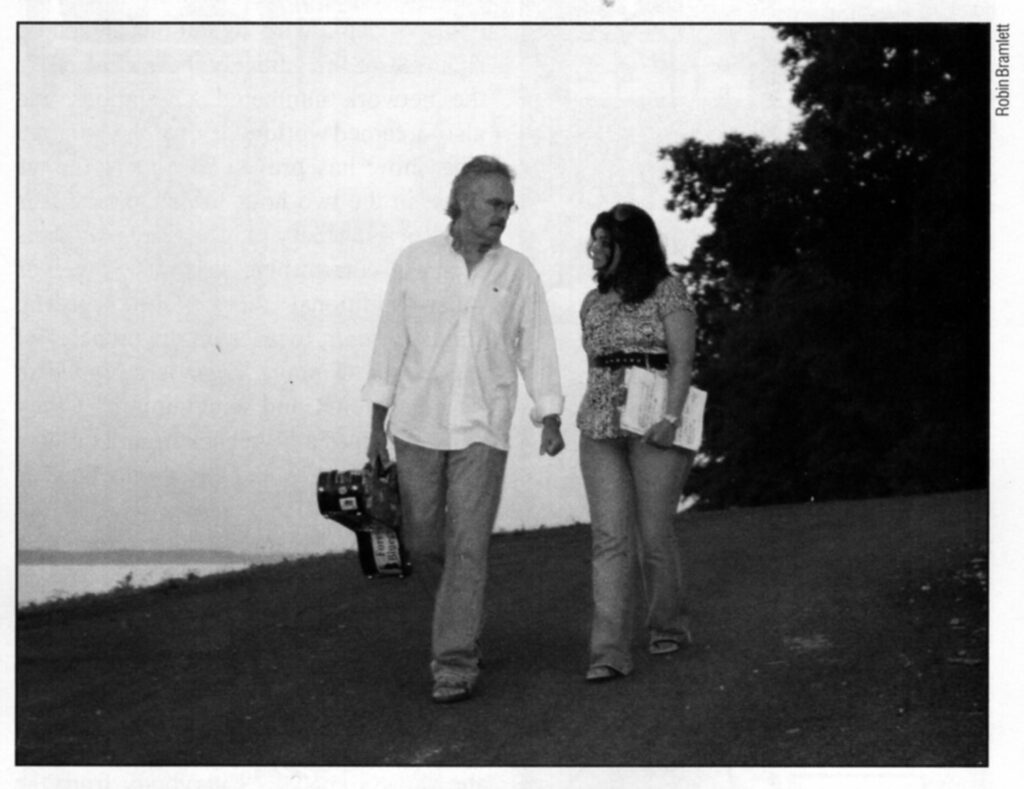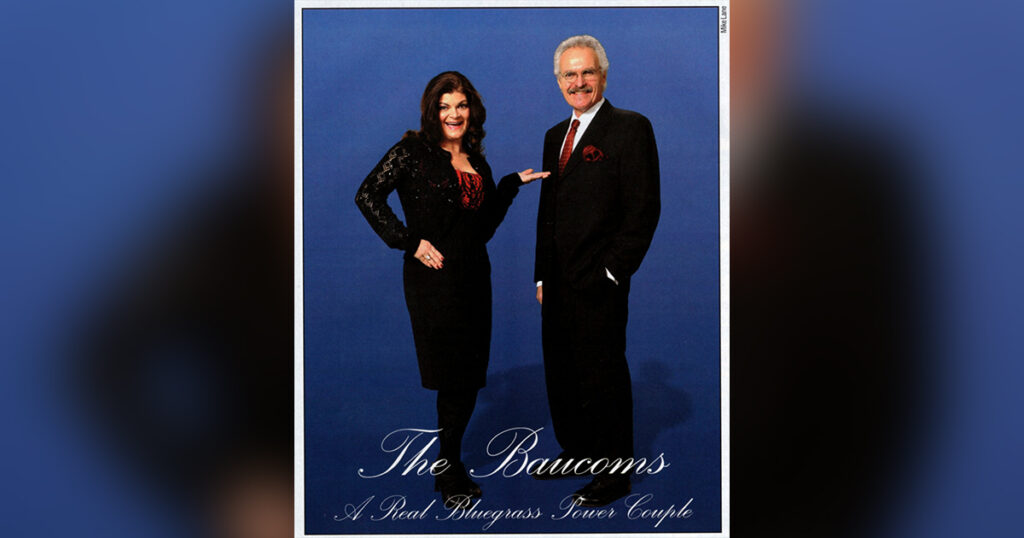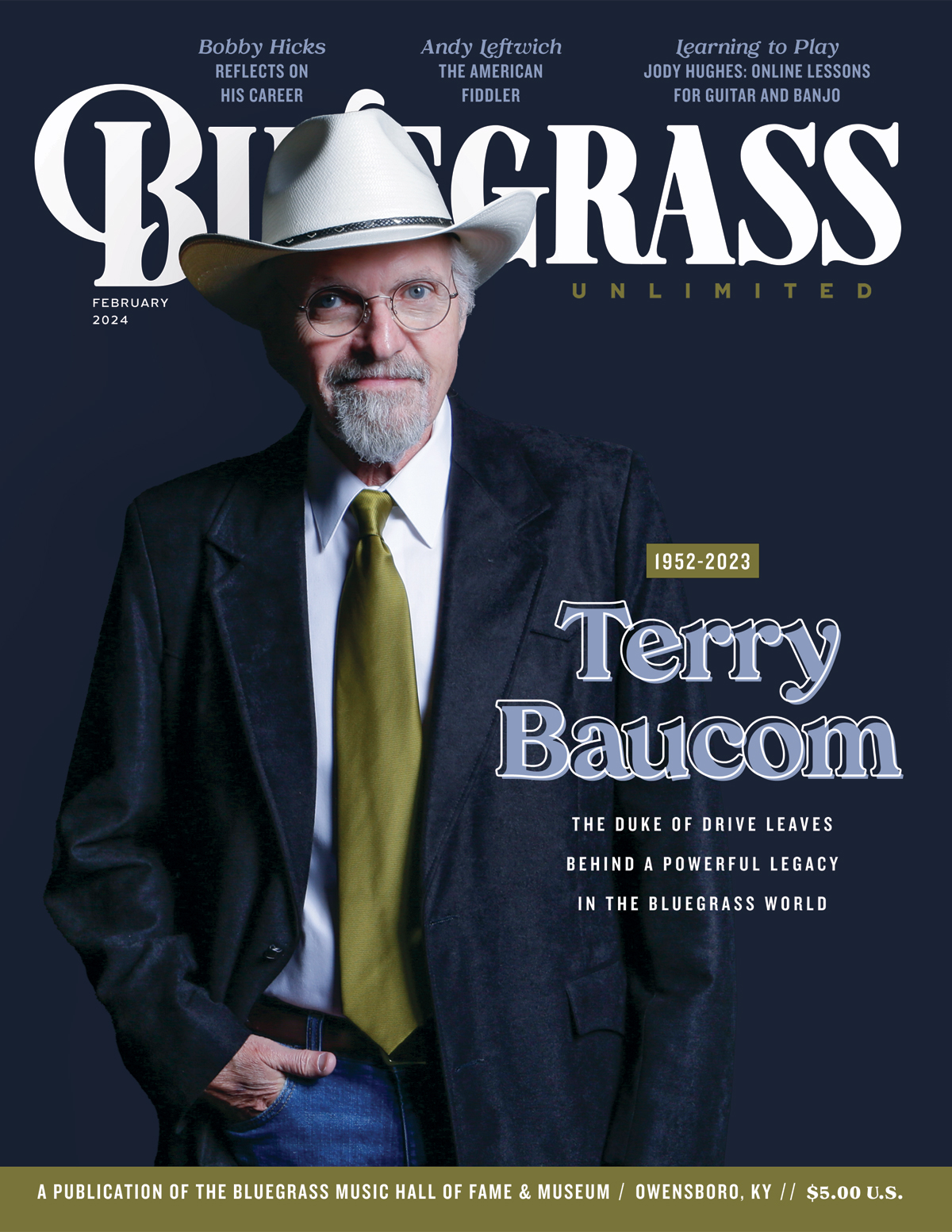Home > Articles > The Archives > The Baucoms — A Real Bluegrass Power Couple
The Baucoms — A Real Bluegrass Power Couple
Reprinted from Bluegrass Unlimited Magazine
August 2012, Volume 47, Number 2
It may sound like a setup for a really bad banjo joke, but five-strings can bring people together. And, in at least one case, help forge a bluegrass power couple. Terry Baucom has established himself among the great banjo pickers of the last four decades, helping found some of the biggest names in bluegrass history and some of the top groups on the circuit today. Entering his 43rd year as a performer, Terry has released his first solo CD, In A Groove, which is loaded with hard-driving bluegrass and boasts an all-star lineup of vocalists.
Cindy Baucom started her broadcasting career in high school and today her syndicated bluegrass radio show Knee Deep In Bluegrass can be heard on more than 85 stations across the country. Not only does she perform on the side, but she’s also built a solid following as a festival emcee. They play music together, collaborate on albums and sessions, tour, endorse products, and hit the airwaves making an all-bluegrass living together. And neither has any plans to slow down after a combined seventy-plus years in the business. “We still enjoy traveling,” Terry says. “And we’re not planning on ever quitting.”
Terry: Fiddle and Banjo
Terry, who grew up appropriately enough in Monroe, N.C., got his start on the banjo when he was ten years old, coming from a line of guitar, fiddle, and clawhammer players. A seminal TV show struck a chord (pun intended) with him, and then his parents got him started with a Kay openback. “The Beverly Hillbillies were big and Earl got me into it,” he says. “After about a year, I got an RB-100 from one of my dad’s co-workers, and a couple of years after that I’d go out on Friday nights with my dad to jam with a fiddle player and a bass player. Not long after that, I started entering contests at fiddle conventions.”
In addition to Scruggs, Baucom picked up licks by listening to J.D. Crowe, Sonny Osborne. Bill Emerson, and a host of other first and second generation pickers. By the time he was 18, Terry was getting pretty good, so he promptly put his banjo to the side. “I started messing around with the fiddle, and the banjo just took a backseat,” he says. “Charlie Moore was at a festival in Hickory, N.C., and he was looking for a fiddle player. I got an audition right there on stage and got hired. My first paying gig was playing the Grand Ole Opry on a Friday night.”
Terry played with Moore for a couple of years and then with a busy North Carolina banjo player named L.W. Lambert. But his breakout would come in the mid-1970s when he would begin a crazy string of founding some of the top bands in bluegrass. “I had gotten to know Ricky Skaggs and Keith Whitley from festivals when they were with Ralph Stanley, and we had talked about starting a group for years,” Terry says. “Lou Reid was coming in on bass, Marc Pruett was going to play banjo, Wes Golding on guitar, and Jerry Douglas on Dobro.”
That group, of course, became Boone Creek and was the first group that Skaggs, just 23 at the time, fronted. Terry was supposed to fill in and rotate fiddle duties with Skaggs, but ended up taking on a different role. “Marc had just opened a music store, and that demanded his time,” Terry recalls. “So, he had to opt out. We needed a banjo, so I stepped into that spot.”
The group only stayed together for two years, before Skaggs left to join Emmylou Harris. Baucom moved back to Charlotte and did some part-time gigs and teaching before he got another call. Doyle Lawson was going out on his own and forming the band that would become known as Quicksilver. He was joined by Reid and friend Jimmy Haley, and the band took off with Terry holding the banjo job for six years. By 1985, he had settled back into teaching and fill-in work for the rest of the decade. That is until some key members of Quicksilver decided it was time for them to try their hand at their own band.
Russell Moore, Ray Deaton, and Mike Hartgrove were putting together the framework for lllrd Tyme Out and wanted Terry to kick them off. “Russell called me and put that group together, and that was a good time,” Terry says. “Then Lou Reid came in and, with him and Russell, that singing was the best of the best.” lllrd Tyme Out took the IBMA award for Vocal Group Of The Year in 1994.
In ’94, Terry and Reid put another group together—Lou Reid, Terry Baucom and Carolina—and they recorded two projects over the next three years. The group won the first-ever Emerging Artist Of The Year award. After leaving that group, Terry joined with Randy Graham, Haley, Bibey and, later, Junior Sisk to put together Blueridge (also known as Baucom, Bibey & Blueridge), one of the hottest festival draws around. He took home another IBMA award for Instrumental Recorded Performance Of The Year for Knee-Deep In Bluegrass: The
AcuTab Sessions, a multi-artist compilation for Rebel Records in 2001.
After that run, an old friend called him. “Dale Perry was leaving [2003], and I’ve been such good friends with Doyle,” Terry says with a laugh. “You just have to know that he is very persuasive. He talked me into it. It was great. He had Jamie Dailey and Barry Scott on vocals and Jesse Stockman on fiddle—they were so polished.”
Baucom stayed with his old friend for another four years, collecting more IBMA awards for Gospel Song Of The Year (2003, 2005, 2006) and Vocal Group Of The Year (2003, 2004, 2005, 2006), but the lifestyle began to wear on him. “We were gone all the time, and I loved the people I was playing with and the music we were playing, but it was just tough being gone so much,” Terry says. “I would have loved to have had that job at 25.”
Terry didn’t take himself completely out of the game though. He played dates with Junior Sisk, Kenny & Amanda Smith, and Dale Ann Bradley, among others.
Born Into It

Cindy grew up in the mountains of Ashe County, North Carolina in the little town of West Jefferson. Situated where Virginia, Tennessee, and the Tar Heel State all come together, she was in a hotbed of bluegrass music. Her dad, Jim Brooks, was “eat up with it” as they say, a multi-instrumentalist and bandmember who kept his little girl close at hand. “I remember there were always jams at the house, and every place we’d go on the weekends involved music,” remembers Cindy. “My earliest memories are all about music. Dad would play and rehearse, and I’d play name that tune. Those times instilled a passion in me for the music.”
She started playing the guitar in eighth grade and a year later her dad’s band needed a bass player, so she learned to play. “That’s my main instrument to this day,” she says.
She got her first job in radio at age 17, doing a local bluegrass show on WKSK, The Bluegrass Spectacular, after school on Mondays and Tuesdays. She parlayed that into a full-time job at a station in nearby West Jefferson upon graduation. She learned all facets of the industry—working on-air, writing, and producing commercials, as well as working as a receptionist.
She took time out in 1987 to compete in the Miss North Carolina Pageant as she moved to North Wilkesboro, becoming program director for WKBC. That proved to be a fortuitous opportunity. “MerleFest began there in 1988. and it gave me the chance to get in on the ground floor,” Cindy says. “The first year, I was a volunteer. The second year, I did station setup on site for artist interviews. By the third year, I was emceeing on the main stage, and I’m still doing that. It gave me experience with live shows. So much of bluegrass is relationships, the feeling of closeness, of family.”
After nearly nine years, she moved to WFMX in Statesville, a post she would hold for most of a decade. She worked in advertising and on morning shows, but her breakout came with what seemed like might be just another fun side gig. “An FM station, WWCC in Greensboro. N.C., asked me to do a bluegrass show on the weekends,” she says. “While I was doing that show, Ed Lowe, the CEO of the John Boy & Billy radio network would listen. Then, he was in the audience at a show where I sang with the Kruger Brothers at MerleFest. He went to a bluegrass weekend hosted by John Lawless in Roanoke, Virginia, and was starting to get into banjo, and asked John about teachers in the Charlotte area. John gave him Terry’s name.”
For those unfamiliar with John Boy & Billy, the duo hosts a morning comedy radio show compatible with several genres of music and with mass appeal. Their good ole boy appeal stretches the network’s reach across the Southeast and into other parts of the country, including an offering of merchandise from CDs to barbecue sauce. In short, they are broadcast power hitters. “Ed told Terry that John Boy and Billy really loved bluegrass and wanted to help push the music,” Cindy says. “He asked Terry if he thought I’d be interested in syndicating my bluegrass show.”
Cindy jumped at the chance and on July 4, 2003, Knee-Deep In Bluegrass made its debut with 28 stations signed up right out of the gate. By the end of 2011, the network numbered 87 stations and also streamed worldwide over the Internet. The show has proven to give a ratings boost in the two-hour format, where it is used as a specialty plug-in. The playlist is a mix of current bluegrass hits as well as older traditional tunes. One segment, Vintage Vault, focuses on the pioneers of the genre. “Vintage Vault is designed to be educational and entertaining,” Cindy says. “It gives a little background on who these folks were and also who they’ve influenced.”
There is also an interview segment in which Cindy interviews a different performer each week in a conversational style sprinkled with a selection of songs by the artist. Feedback tells her this is the segment that gets the most attention, and she is still surprised after nine years with the show’s appeal. “Everybody from the paper-delivery person to doctors will tell me they look forward to the show,” she says. “I think people listening feel more grounded, that maybe this was something their grandparents might have listened to or even played, and it takes folks back to a happy place.”
In 2012, Cindy will be inducted into the Blue Ridge Music Hall Of Fame, which showcases and preserves the musical heritage of the mountain range that extends from northern Georgia to northern Virginia.
Brought Together by Bluegrass
Love might have gotten Cindy and Terry to the altar, but it was bluegrass festivals that brought them together. “I’ve known who Terry was for as long as I can remember. He was always around at places my dad was playing.” Cindy says. “We got better acquainted in the late 1990s when I was emceeing and he was playing all over the place.”
Both of them had been married before, but not to spouses in the business. “We had a lot in common. He told me once, ‘You’re the only chick I’ve dated that I could pick with,’” Cindy laughs. “Because we are both so busy, it helps us to understand each other and be supportive. When Doyle called him back out, I encouraged him to go. I understand his heart is with the music, because mine is there, too.”
When Terry decided after four decades that it was maybe time to get out his debut solo album, he didn’t come up with a modest effort. And it was not an endeavor to go at alone—he and Cindy coproduced the project. “We talked to a lot of labels, but it just made sense to go with the John Boy & Billy label,” Cindy says of the first project done outside of the comedy duos own work. “It was the best fit because of our relationship with them and we were given a hundred percent creative freedom of how to do it.”
In A Groove not only features Terry’s driving banjo, but it’s also loaded with appearances from the top acts in the business. The first single out of the box, with vocals by Jamie Dailey and Lou Reid, was “Do You Wrong Kind Of Girl.” Next came “Good Time Mountain Man,” written and performed by Chris Stapleton and Ronnie Bowman. Old bandmates Lawson, Haley, and Reid reunite for “My Eyes Shall Be On Canaan’s Land,” and the lineup continues with more singing by the trademark voices of Buddy Melton (Balsam Range), Moore, Don Rigsby. Paul Williams, John Cowan. Adam Steffey (Boxcars), the Gibson Brothers, and Cindy on two cuts. In short, Terry pulled out all the stops and gave fans, who were probably expecting an instrumental banjo album, a nice surprise.
“I’m proud of the album. It turned out well,” Terry says. “Barry Bales, Adam,
Jason Carter, and Wyatt Rice made up the band. We laid ten tracks the first day. We didn’t run into any problems. It was more fun than hassle, and sometimes that is not the case. You can be really tired of a project by the time you’re done.”
Despite the fact that Terry is not in a band, he is still running in high gear and getting plenty of places to promote his work. Late in 2011, he was playing dates with the Josh Williams Band, Mashville Brigade, Mountain Heart with Tony Rice, and Pine Mountain Railroad. He toured Japan earlier this year with Cindy, Don Rigsby, Rickie Simpkins, and Maro Kawabata.
It is a testament to Terry’s career just to consider the fact that, over the years, he’s had four different banjo models carry his signature. He’s had a Sullivan, a Rich & Taylor, a Gibson prototype and his current favorite, a custom designed Deering banjo. It has a red maple rim, a tone ring that is six ounces lighter than usual, a walnut neck and resonator, and it has…well…it. “It doesn’t sound new, and it’s only about three years old,” Terry says. “Sometimes it can take up to five years to break one in. Every note of the album was recorded with it.”
While it does help to have a great instrument, it is no doubt that the right hand of the player makes the difference. Years ago, instructional DVD promoter John Lawless of AcuTab gave Terry the moniker “The Duke of Drive” and the resulting DVD Driving With The Duke. If you ask Terry what all went into that makeup, you might not get the answer you expect. “Besides the classics, I like stuff from Freddie Mercury [of rock band Queen], Merle Haggard, I like ragtime, and I like Dixieland,” he says. “I just like all kinds of music if it’s done right. If it’s done well, you find something you like. Musical style is all part of influences you’ve heard. You’re not really thinking about them, they just come out. What we did with Boone Creek at the time was out of left field compared to what was considered ‘normal’ at the time.”
With Terry’s career driving ahead and Cindy’s radio show reaching more listeners every year, this bluegrass power couple is showing no signs of slowing down. And that has to be a good sign for bluegrass music fans everywhere.
Share this article
1 Comment
Leave a Comment Cancel Reply
This site uses Akismet to reduce spam. Learn how your comment data is processed.


Wonderful and talented folks!Sure miss Terry.